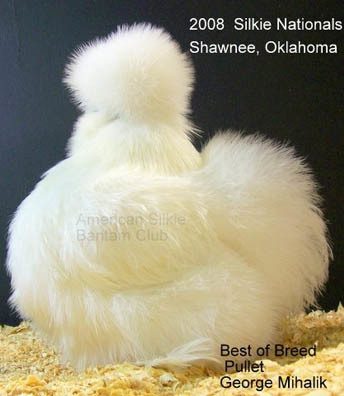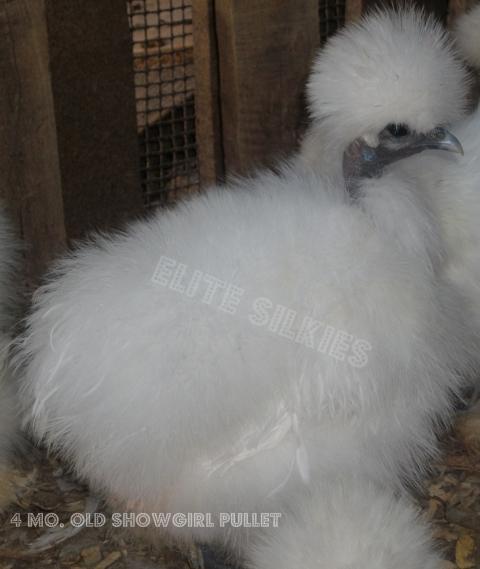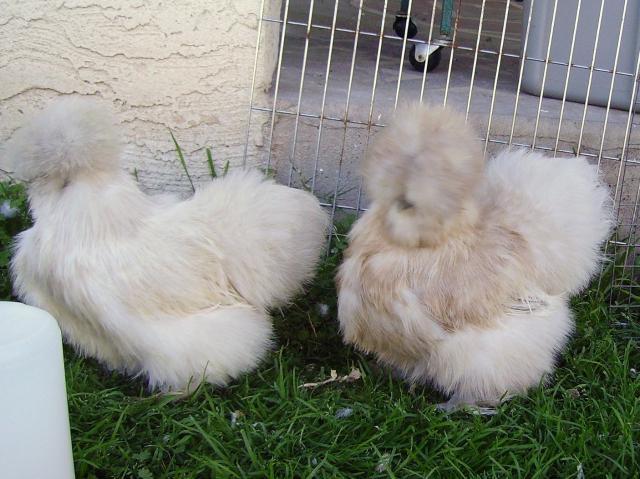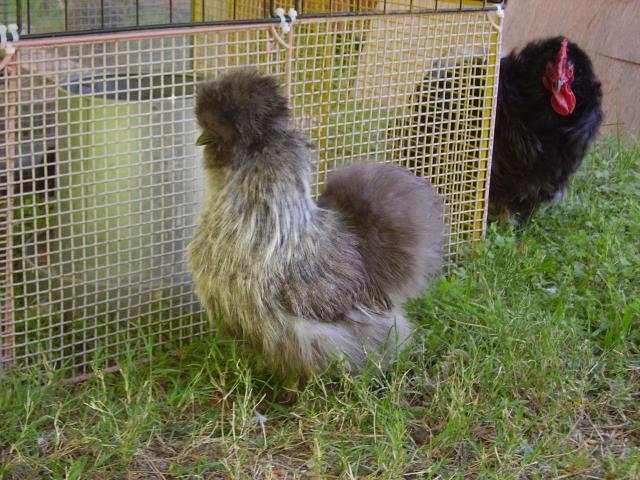Quote:
The ideal Silkie type is spelled out word for word in the Standard of Perfection.
Disqualifications
Bright red comb, face and wattles. Shanks not feathered down outer sides. Feathers not truly silky (except in primaries, secondaries, leg, toe, and main tail feathers.) Vulture hocks.
Standard Weights
Cock 36 oz. Hen 32 oz.
Cockerel 32 oz. Pullet 28 oz.
Shape - Male and Female
Comb
Male - Walnut - set firmly and evenly on head, almost circular in shape, preferably broader than longer, with a number of small prominences over it, a slight indentation or furrow transversely across the middle, rising at a point just forward of the nostrils and extending backwards to a point parallel with front of eyes.
Female - Walnut - very small, well formed. Rest of the description same as the male.
Color:
Non-Brd & Brd Black Deep mulberry approaching black
Non-Brd & Brd White Deep mulberry approaching black
Brd & Non-Brd Blue Deep mulberry
Brd & Non-Brd Partridge Deep mulberry
Brd & Non-Brd Buff Deep mulberry
Brd & Non-Brd Gray Deep mulberry
Beak
Short and stout, curving point.
Color:
Non-Brd & Brd Black Leaden Blue
Non-Brd & Brd White Leaden Blue
Brd & Non-Brd Blue Bluish Black
Brd & Non-Brd Partridge Bluish Black
Brd & Non-Brd Buff Slaty Blue
Brd & Non-Brd Gray Slaty Blue
Face
Surface smooth, skin fine and soft in texture.
Color:
Non-Brd & Brd Black Deep mulberry approaching black
Non-Brd & Brd White Deep mulberry approaching black
Brd & Non-Brd Blue Deep mulberry
Brd & Non-Brd Partridge Deep mulberry
Brd & Non-Brd Buff Deep mulberry
Brd & Non-Brd Gray Deep mulberry
Eyes
Large, round, prominent.
Color: Black
Wattles
Male
Non-Bearded - Medium size, concave, nearly round, fine in texture, free from wrinkles or folds.
Bearded - Very small, concealed by beard.
Female
Non-Bearded - Small, concave, forming a half circle, fine texture, free from wrinkles or folds.
Bearded - Small to nonexistent, concealed by beard.
Color:
Non-Brd & Brd Black Deep mulberry approaching black
Non-Brd & Brd White Deep mulberry approaching black
Brd & Non-Brd Blue Deep mulberry
Brd & Non-Brd Partridge Deep mulberry
Brd & Non-Brd Buff Deep mulberry
Brd & Non-Brd Gray Deep mulberry
Ear Lobes
Male
Non-Bearded - Small, oval, fine in texture, free from wrinkles or folds.
Bearded - Very small, almost concealed by muffs.
Female
Very small. Rest of the discription same as the male.
Color:
Non-Brd & Brd Black Light Blue Turquoise
Non-Brd & Brd White Light Blue Turqouise
Brd & Non-Brd Blue Turqouise Blue
Brd & Non-Brd Partridge Turqouise Blue
Brd & Non-Brd Buff Turqouise Blue
Brd & Non-Brd Gray Turqouise Blue
Crest
Male
Medium size, soft and full, as upright as comb will permit, having a few silky feathers streaming gracefully backwards from lower and back part of crest.
Female
Medium size, soft and full, globular, upright, well balanced.
Head
Modestly small, short, carried so that a line drawn parallel with tip of the tail will bisect the comb.
Beard and Muffs
Bearded varieties
Thick, full, extending back of eyes and projecting from sides of face and composed of feathers turned horizontally backwards, from both sides of the beak, from the center, vertically downwards, the whole forming a collar of three ovals in a triangular group, giving a muffed effect.
Neck
Short, gracefully arched, with very full hackle flowing well over shoulders.
Back
Male
Short, broad from shoulders to saddle, quite rounded its entire length rising gradually from middle of back towards tail.
Female
Short, broad from shoulders to cushion, quite rounded its entire length, rising gradually from middle of back towards tail.
Saddle
Male
Rising from back at base of cape, very broad and round, plumage profuse and long, lower saddle feathers flowing over tips of wings and mingling with fluff.
Cushion
Rising from back at base of cape, very broad and round, plumage abundant.
Tail
Male
Short, very shredded at ends, well spread at base, filled underneath with an abundance of soft feathers which are overlapped by coverts and lesser sickles, the whole forming a duplex curve with back and saddle. Sickles, lesser sickles, and coverts abundant, soft, well curved, without hard quills, concealing main tail feathers.
Female
Short, very shredded at ends, well spread at base, filled underneath with an abundance of soft feathers which are overlapped by cushion and coverts, the whole forming a duplex curve with back and cushion.
Wings
Medium size, closely folded, carried well back and nearly horizontal, well above lower thighs ending short of stern.
Shoulders and fronts: concealed by hackle and breast feathers.
Bows and coverts: very well rounded.
Primaries: medium length, well shredded, concealed by secondaries.
Secondaries: medium length, well shredded, tapering convexly to stern, tips concealed by saddle feathers.
Breast
Carried forward, very full, well rounded and of great depth and width.
Body and Fluff
Body of moderate length, broad, deep and well rounded from breast bone to stern and let down well between the legs.
Legs and Toes
Male
Legs: short, stout, set well apart, straight when viewed from front.
Lower thighs: short, stout at top, tapering to hocks, abundantly feathered.
Hocks: covered with soft and silky feathers curving inwards about the hocks.
Shanks: rather short, stout in bone well feathered on outer sides with silky plumage, the upper part growing out from under thigh plumage and continuing into foot feathering.
Spurs: medium size and length, set just above fifth toe.
Toes: five, the three front straight, well and evenly spread, the hind toe double, the normal toe in natural position and the extra toe placed above, starting from close to the other toe and curving upwards and backwards, the outer and middle toe well feathered.
Female
Same as male except no spur.
(Bare middle toe a serious defect in either sex.)
Skin
Dark blue
Appearance
Male
Active bold, silky and fluffy.
Female
Active, sedate, silky and fluffy
The ideal Silkie type is spelled out word for word in the Standard of Perfection.
Disqualifications
Bright red comb, face and wattles. Shanks not feathered down outer sides. Feathers not truly silky (except in primaries, secondaries, leg, toe, and main tail feathers.) Vulture hocks.
Standard Weights
Cock 36 oz. Hen 32 oz.
Cockerel 32 oz. Pullet 28 oz.
Shape - Male and Female
Comb
Male - Walnut - set firmly and evenly on head, almost circular in shape, preferably broader than longer, with a number of small prominences over it, a slight indentation or furrow transversely across the middle, rising at a point just forward of the nostrils and extending backwards to a point parallel with front of eyes.
Female - Walnut - very small, well formed. Rest of the description same as the male.
Color:
Non-Brd & Brd Black Deep mulberry approaching black
Non-Brd & Brd White Deep mulberry approaching black
Brd & Non-Brd Blue Deep mulberry
Brd & Non-Brd Partridge Deep mulberry
Brd & Non-Brd Buff Deep mulberry
Brd & Non-Brd Gray Deep mulberry
Beak
Short and stout, curving point.
Color:
Non-Brd & Brd Black Leaden Blue
Non-Brd & Brd White Leaden Blue
Brd & Non-Brd Blue Bluish Black
Brd & Non-Brd Partridge Bluish Black
Brd & Non-Brd Buff Slaty Blue
Brd & Non-Brd Gray Slaty Blue
Face
Surface smooth, skin fine and soft in texture.
Color:
Non-Brd & Brd Black Deep mulberry approaching black
Non-Brd & Brd White Deep mulberry approaching black
Brd & Non-Brd Blue Deep mulberry
Brd & Non-Brd Partridge Deep mulberry
Brd & Non-Brd Buff Deep mulberry
Brd & Non-Brd Gray Deep mulberry
Eyes
Large, round, prominent.
Color: Black
Wattles
Male
Non-Bearded - Medium size, concave, nearly round, fine in texture, free from wrinkles or folds.
Bearded - Very small, concealed by beard.
Female
Non-Bearded - Small, concave, forming a half circle, fine texture, free from wrinkles or folds.
Bearded - Small to nonexistent, concealed by beard.
Color:
Non-Brd & Brd Black Deep mulberry approaching black
Non-Brd & Brd White Deep mulberry approaching black
Brd & Non-Brd Blue Deep mulberry
Brd & Non-Brd Partridge Deep mulberry
Brd & Non-Brd Buff Deep mulberry
Brd & Non-Brd Gray Deep mulberry
Ear Lobes
Male
Non-Bearded - Small, oval, fine in texture, free from wrinkles or folds.
Bearded - Very small, almost concealed by muffs.
Female
Very small. Rest of the discription same as the male.
Color:
Non-Brd & Brd Black Light Blue Turquoise
Non-Brd & Brd White Light Blue Turqouise
Brd & Non-Brd Blue Turqouise Blue
Brd & Non-Brd Partridge Turqouise Blue
Brd & Non-Brd Buff Turqouise Blue
Brd & Non-Brd Gray Turqouise Blue
Crest
Male
Medium size, soft and full, as upright as comb will permit, having a few silky feathers streaming gracefully backwards from lower and back part of crest.
Female
Medium size, soft and full, globular, upright, well balanced.
Head
Modestly small, short, carried so that a line drawn parallel with tip of the tail will bisect the comb.
Beard and Muffs
Bearded varieties
Thick, full, extending back of eyes and projecting from sides of face and composed of feathers turned horizontally backwards, from both sides of the beak, from the center, vertically downwards, the whole forming a collar of three ovals in a triangular group, giving a muffed effect.
Neck
Short, gracefully arched, with very full hackle flowing well over shoulders.
Back
Male
Short, broad from shoulders to saddle, quite rounded its entire length rising gradually from middle of back towards tail.
Female
Short, broad from shoulders to cushion, quite rounded its entire length, rising gradually from middle of back towards tail.
Saddle
Male
Rising from back at base of cape, very broad and round, plumage profuse and long, lower saddle feathers flowing over tips of wings and mingling with fluff.
Cushion
Rising from back at base of cape, very broad and round, plumage abundant.
Tail
Male
Short, very shredded at ends, well spread at base, filled underneath with an abundance of soft feathers which are overlapped by coverts and lesser sickles, the whole forming a duplex curve with back and saddle. Sickles, lesser sickles, and coverts abundant, soft, well curved, without hard quills, concealing main tail feathers.
Female
Short, very shredded at ends, well spread at base, filled underneath with an abundance of soft feathers which are overlapped by cushion and coverts, the whole forming a duplex curve with back and cushion.
Wings
Medium size, closely folded, carried well back and nearly horizontal, well above lower thighs ending short of stern.
Shoulders and fronts: concealed by hackle and breast feathers.
Bows and coverts: very well rounded.
Primaries: medium length, well shredded, concealed by secondaries.
Secondaries: medium length, well shredded, tapering convexly to stern, tips concealed by saddle feathers.
Breast
Carried forward, very full, well rounded and of great depth and width.
Body and Fluff
Body of moderate length, broad, deep and well rounded from breast bone to stern and let down well between the legs.
Legs and Toes
Male
Legs: short, stout, set well apart, straight when viewed from front.
Lower thighs: short, stout at top, tapering to hocks, abundantly feathered.
Hocks: covered with soft and silky feathers curving inwards about the hocks.
Shanks: rather short, stout in bone well feathered on outer sides with silky plumage, the upper part growing out from under thigh plumage and continuing into foot feathering.
Spurs: medium size and length, set just above fifth toe.
Toes: five, the three front straight, well and evenly spread, the hind toe double, the normal toe in natural position and the extra toe placed above, starting from close to the other toe and curving upwards and backwards, the outer and middle toe well feathered.
Female
Same as male except no spur.
(Bare middle toe a serious defect in either sex.)
Skin
Dark blue
Appearance
Male
Active bold, silky and fluffy.
Female
Active, sedate, silky and fluffy





